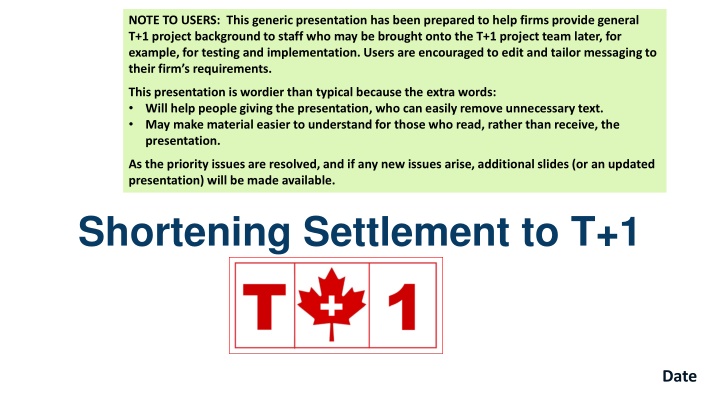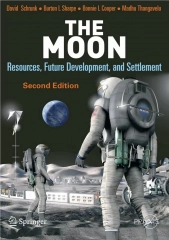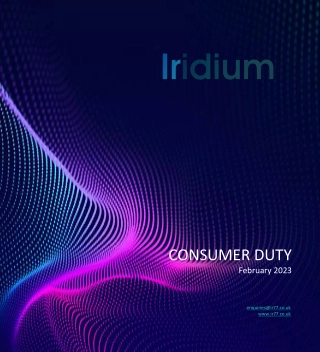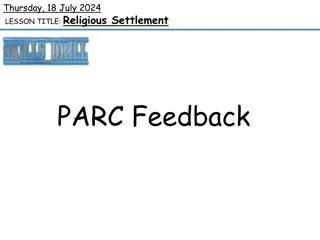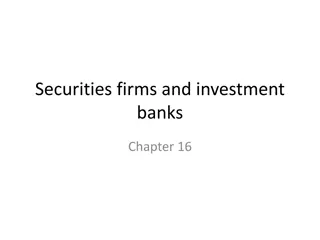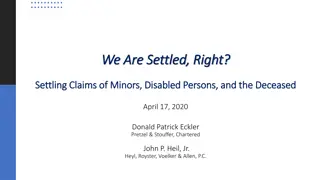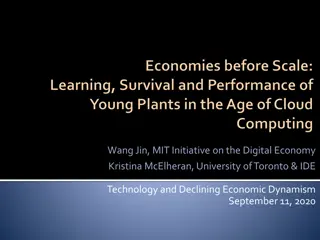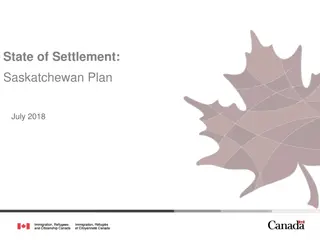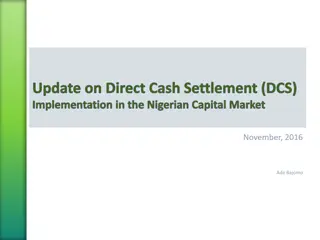Helping Firms Understand T+1 Settlement
This presentation provides insights into the significance of T+1 settlement in the financial industry. It outlines the challenges, benefits, and the necessity for Canada to transition to T+1. Discover why this shift matters and the key factors driving the move to expedited settlement processes.
Download Presentation

Please find below an Image/Link to download the presentation.
The content on the website is provided AS IS for your information and personal use only. It may not be sold, licensed, or shared on other websites without obtaining consent from the author.If you encounter any issues during the download, it is possible that the publisher has removed the file from their server.
You are allowed to download the files provided on this website for personal or commercial use, subject to the condition that they are used lawfully. All files are the property of their respective owners.
The content on the website is provided AS IS for your information and personal use only. It may not be sold, licensed, or shared on other websites without obtaining consent from the author.
E N D
Presentation Transcript
NOTE TO USERS: This generic presentation has been prepared to help firms provide general T+1 project background to staff who may be brought onto the T+1 project team later, for example, for testing and implementation. Users are encouraged to edit and tailor messaging to their firm s requirements. This presentation is wordier than typical because the extra words: Will help people giving the presentation, who can easily remove unnecessary text. May make material easier to understand for those who read, rather than receive, the presentation. As the priority issues are resolved, and if any new issues arise, additional slides (or an updated presentation) will be made available. Shortening Settlement to T+1 Date
Agenda What is T+1 and why does it matter? Six challenges to reaching T+1 Issues addressed so far Major issues still to address What about transition? What we re doing right now [insert additional sections as desired]
What is T+1? T+2, T+1, T+0 refer to the number of business days it takes to settle a trade that is, exchange securities for payment after trade execution T+2 = trade date + 2 days the current standard for securities except money market instruments T+1 = trade date + 1 day And it s short-hand for the Canadian industry initiative to shorten settlement to T+1
Why and why now? Partly tackling 2021 Gamestop/Robinhood market volatility Benefits: Less counterparty risk (that trade party can t deliver cash, security) For dealers: less margin, liquidity, clearing capital requirements For institutional & retail investors: more efficient, safer, better service BUT benefits and costs among industry participants unequal Transition: Canada & U.S. wanted Labour Day 2024 weekend, but: U.S. regulators set May 28, 2024 U.S. long weekend Canada set May 27, 2024 to migrate due to risk
Why must Canada move to T+1? Canada and the U.S. moved to T+5, T+3, and T+2 together ~25% of transactions and 40% of value traded in Canada are in interlisted securities listed on Canadian and U.S. exchanges Study showed Canadian markets should keep on same cycle as U.S. or lose business Canadian participants must change either way either to: Match the shorter U.S. settlement cycle OR Change systems/process to accommodate different U.S. cycle
Challenge 1 What a difference a day makes From T+5 to T+3 to T+2 easy ; from T+2 to T+1 much harder: Less time to provide allocations No day between trade and settlement to fix errors via batches For T+1 trades in different currencies, there will be a mismatch with major currencies (except CAD/USD) that settle T+2 Less time to initiate recalls/find alternative securities to borrow Liquidity, timing problems with ETF create process Extra complexity as North America at end of global trading day Can t just do more faster; must change systems/processes 8
Challenge 2 North America is deharmonizing Instead of joining Europe, Asia (as in T+2 move), we (U.S., Canada with Mexico) are leaving most other countries behind 9
Challenge 3: Regulatory issues U.S. U.S. regulator (SEC) took > a year to set date, left a year to go Unlike 2017 move to T+2, SEC didn t listen re transition date SEC said intent to shorten settlement to T+0 is off the table for now; no clarity on timing re T+0 delayed industry participant decisions T+1 goal is less risk, but delays/uncertainty may increase fail risk that trade won t settle if money or security can t be delivered Fails currently ~2% in Canada and U.S. 10
Challenge 3: Regulatory issues Canada (contd.) Industry says 90% of trades should match by 3:59 a.m. ET T+1 to: Maximize flexibility for Canadian participants nationwide (firms also can choose to adopt DTCC s 9 p.m. ET on T matching) Help counterparties operating in non-Canadian time zones Allow custodians and buyside firms more time to affirm trades Better enable sell-side firms to manage collateral/settlement/etc. CSA Staff Notice 24-319 cites intent to recommend 3:59 a.m. T+1 National Instrument (NI) 81-102 Investment Funds NOT changing; likely won t know until next year what mutual funds will move to T+1 11
Challenge 4: Were far from matching goal Some progress 2021 to 2023, but a long way to go # entered/allocated on T must increase 30%; $ must rise by 25% # matched must double or triple; $ must rise by 50-60% 12
Challenge 5: Blame game Exchange trades not likely a problem, institutional trades are Three parties to an institutional trade: Is Broker/Dealer trade entry late? Is Investment Manager allocation late? Is CUstodian confirmation late? Are funds/securities available for release on time (BD/IM/CU)? Are securities loanrecalls or FX to blame? Competitors must collaborate or settlement chain breaks 1. IM sends order to BD 2. BD advises IM of fill 3. IM provides allocations to BD and CU 4. BD and CU records of IM trade/ allocations match or not at CDS 13 www.ccma-acmc.ca | info@ccma-acmc.ca
Challenge 6: Not much time to automate Where is our firm on this timeline? What are our dependencies on third parties? 14
Are these challenges solvable? Yes, with . AUTOMATION AUTOMATION AUTOMATION
Issue logs used to identify/solve issues Industry-wide issue logs on Canadian Capital Markets Association (CCMA) website CCMA: An umbrella group of financial associations, industry participants, infrastructure (marketplaces, CDS, CDCC, Fundserv), service providers, vendors, with regulators CCMA role: Launched in 1999; communicates, educates, helps co-ordinate cross-capital-markets projects CCMA T+1 Steering Committee; operations, mutual funds, legal/ regulatory issues, communications/education subcommittees Follow CCMA on LinkedIn; sign up for monthly newsletter/update info@ccma-acmc.ca; visit FAQs on www.ccma-acmc.ca)
Scheduled activity changes CDS Job Scheduler/Timeline Hourly 10 a.m.-4 p.m. T: Marketplaces submit trades (currently end-of-day) Hourly 11 a.m.-5 p.m. T: CDS returns exchange-trade messages/files (currently end-of-day) By 7:30 p.m. on T: BDs enter allocated ITP trades By 3:59 a.m. T+1: IMs/BDs/CUs confirm ITP trades 19 www.ccma-acmc.ca | info@ccma-acmc.ca
What securities will move to T+1? Canadian Asset List on ccma-acmc.ca; for U.S., dtcc.com/ust1 All non-fund securities currently settling on T+2 standard Equities and other platform-traded securities (e.g., ETFs) Government and corporate bonds Derivatives Not affected T-bills already settle same-day (T) Money market mutual funds, options already settle T+1/T New issues, special terms , not regular way Mutual funds? Unknown more later
Funds may/may not go to T+1? Unknown mutual funds, segregated funds, other funds CSA Staff Notice 81-335 Investment Fund Settlement Cycles said T+1 not mandated for mutual funds Recognized T+1 mismatch challenges for some funds Wanted to provide flexibility for manufacturers to decide CSA staff believe many Canadian mutual funds will be able to settle distributions and redemptions on T+1 Staff said where practicable, mutual funds should settle [mutual funds] on T+1 voluntarily. Fund managers to decide which funds move to T+1 44% of mutual funds have at least 10% holdings in securities that will continue to settle on T+2; the uncertainty is unsettling
Funds may/may not go to T+1? Whether fund manufacturers move just some or most funds to T+1, Fundserv will be ready
8 (now 7) Priority issues 1. ResolvedNI 24-101: CSA staff to recommend T+1 rule be amended to require 90% of trades match by 3:59 a.m. ET on T+1 2. Trade pre-match, correct, allocate, confirm: These processes must be condensed a lot for T+1 to avoid more fails 3. Securities lending: Securities loaned may need to be recalled to facilitate settlement; adapt process for T+1 or fails and costs grow 4. Foreign exchange: Spot FX settles on T+2 convention for major currencies (except CAD/USD on T+1); currency/security settlement mismatch risks increased costs and fails 5. ETF creation process: If ETF creation in primary market fails, ETF trades in secondary market will also
8 (now 7) Priority issues (contd.) 5. Industry T+1 test plan: Bilateral/industrywide unscripted and scripted testing is complex, but critical 6. Ex-date processing during T+1 transition: High-volume and/or complex entitlement transactions may cause transition issues 7. Conversion weekend backout plan:T+1 harder, with day to fix things lost; Canada has one day less due to U.S. having a long weekend; SEC hasn t provided for a formal go/no-go decision Note: Priority #2 is up to participants and counterparties/ vendors/infrastructure; #3 to #8 require cross-industry efforts
Priority #3 Securities lending Securities lending systems are disjointed Loan recalls identified as the major obstacle Market practice is to recall by 3 p.m. ET on T+1; will be 3 p.m. on T to allow borrowers last trading hour to process recalls and/or determine if they need to buy back securities TMX/CDS is developing a Recall Portal For use by CDS participants and non-CDS members Interoperable with vendor systems (Equilend, Pirum, etc.), and internal systems used by parties to a securities loan Expected to be implemented next year before T+1 transition
Priority #3 Foreign exchange There are custodians and others that can help address the mismatch between currency settlement on T+2 and trade settlement on T+1 BUT this is still expected to be a problem High demand at end of day of even CAD/USD may lead to liquidity squeezes Process changes to book FX on T? Industry solution?
Priority #6 ETFs Secondary market will be T+1, following marketplace Rules Creation/redemption process under NI 81-102: Focus on ability to provide collateral as part of creation process Working with CSA to obtain blanket exemptive relief Longer term, Canadian ETF Association will: Ask the CSA to update rules to codify exemptive relief Investigate possibility of automating creation/redemption processes through CDS (similar to what DTCC does in U.S.)
Ready or not for May 27, 2024? Canada will transition with U.S.; no delays unless SEC says so Risks of not being ready Increased failed trades Increased costs Market impacts Unhappy clients and regulators How to minimize risk Automate and test, test, test Get in extra staff Allow for greater liquid assets/lines of credit
What is [insert firm name] doing? Reach out: Up- and down-stream to discuss where to cut or compress steps Technology: Autoconfirm/match/correct on T look at process, technology, outsourcing solutions for Canadian and U.S. timelines Portfolio management: Misaligned cycles = funding issues Prefund/arrange credit to cover mismatches (but higher costs) Plan for extra credit/liquidity to cover mismatches at transition Documentation: Check if any have unworkable timelines for T+1; if needed, update trade-matching statement, other agreements, client contracts
What is [insert firm name] doing? Operationally: Look at different alternatives to address: Less time to send/receive sub-advisor corrections Less time to recall securities on loan Less time to instruct/correct FX Process changes: Participants: Consider extending workday so all allocations sent/trades processed before staff leave or shift work elsewhere Dealers/service providers: Look at running trade reconciliations intraday to identify and fix breaks on T Dealers: Be able to create/process on T to settle on T+1
Where is the overall industry now? Despite greater concerns re ability to transition smoothly to T+1 vs T+2 due to greater T+1 complexity and short remaining time Industry survey results show advances in T+1 planning, development, and testing preparation since survey last year 3:59 decision means participants can advance decisively now More service provider solutions coming to market CDS and Fundserv confident they can successfully facilitate testing and transition Failure is not an option (Apollo 13): Canadian capital market participants have shown again and again the ability to deliver
